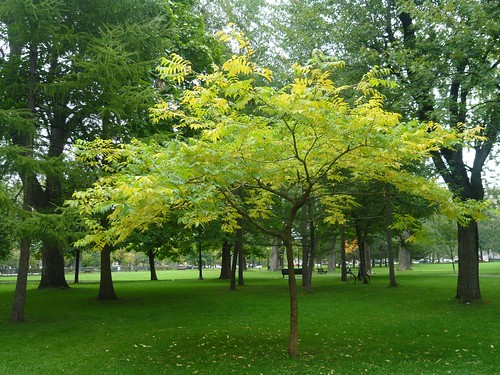
TREE WALK THIS SATURDAY ON MOUNT ROYAL: 1 – 5 PM, meet at Georges-Etienne Cartier statue, $15. See here to register.
The cork used to seal wine bottles comes from the bark of the cork oak (Quercus subur, chêne de liége) that grows principally in Portugal and in six other countries bordering on the Mediterranean. That tree would not survive in our climate. But there is another cork tree, that thrives here. Pictured above is the Amur cork tree (Arbre liège de Chine, Phellodendron amurenses) growing in numerous locations in Parc La Fontaine, as well as on Mount Royal. A native of both China and Russia, the tree grows along the banks of the Amur River, one of the last great rivers yet to be dammed and one which forms the border between the two countries.
Both China and Russia have tried to exploit commercially the corky bark of this tree but without much success. Certainly to the touch, the bark of the Amur cork tree is spongey but whether the spongey layer is deep enough to be harvested without hurting the live layer of bark cells that produce the cork is another question. When you see this tree, by all means sink your thumbnail into the bark to test the sponginess but don’t tree to remove any.
The bark, however, is used medicinally by the Chinese and the entire tree figures among the 50 essential herbs in the Chinese pharmacopaea. A strongly bitter remedy, the bark acts strongly on the kidneys and is regarded as a detoxicant. The oil of the fruit, for instance, contains a variety of biologically active substances, including flavonoids , alkaloids , saponins and coumarins. Medicinal applications of the oil include treatment of pancreatitis, reduction of cholesterol and in blood and the treatment of various skin diseases.
The fruit, now dark blue and grapelike in form and texture, are ripe. It’s worthwhile smelling them. The citrus perfume is a clear indication that the Amur corktree is as member of the citrus, or Rutaceae, family, one of only three such members that are either native or naturalized in northeastern North America. The other two are the stinking ash and the prickly ash, neither of which are ash trees! More on ash confusion in a future blog.

This Saturday, while walking on Mount Royal, you will see a cork tree as well as such look-alikes as the Northern Hackberry and the Butternut.
The best example I know of an old Amur cork tree is the specimen growing on the slope down towards the backside of Redpath Hall on the McGill campus, as you walk up McTavish on the east side. This century-old tree was likely planted when the hall – the University’s first library – was built in 1893. Trees from the Amur river valley, such as the corktree, the Amur maple and the Amur chokecherry had only recently been learned of by western botanists and there was considerable interest in trying them out in eastern North America where the climate is similar.

3 comments
Merci Bronwyn !
Il est si beau d’observer les oiseaux se gaver des fruits de cet arbre aux temps des premières neiges.
Et si beau de voir des gens se gaver de la beauté et du mystère des arbres !
Charles,
Pense-tu que les fruits sont fermentées en ce moment là et les oiseaux cherchent l’alcohol?
Bonne question !
Je ne sais pas , c’est possible .
Je me souviens de ces merles qui se remplissaient le ventre de ces fruits alors qu’il neigeait. Ils étaient plusieurs , c’était tout un spectacle.
Y a aussi la question de l’auto-reproduction de cet arbre sur le Mt-Royal…les oiseaux aidant bien sûr !
Il est intéressant d’observer de jeunes spécimens non plantés par l’humain. J’en ai remarqué quelques-uns.
Je ne croyait pas qu’il pouvait ainsi se perpétuer !
Salut.
Charles.